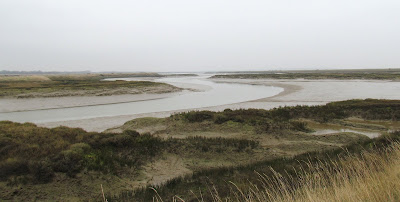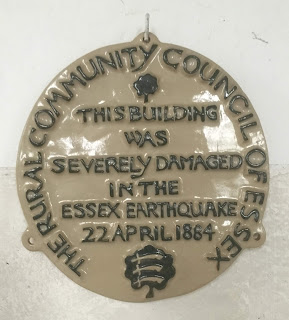Old Hall Marshes
A walk around Old Hall Marshes (7.8 miles)
Saturday 16 February 2019Weather: mild, 14˚C, south-westerly breeze, cloudy
Parked opposite Salcott-cum-Virley church.
(please click on the photos to enlarge them)
The marshes are an area of rare unimproved grazing pasture and creeks protected from the sea by earth banks; outside the sea walls are salt marsh and the mud flats of the creeks along the Blackwater estuary which are exposed and re-flooded with the ebb and flow of the tides. This precious mix of habitats provide a rich food source for numerous bird species and make up the Blackwater Estuary Nature Reserve.
A cloudy day and a flat bleak landscape ... but plenty to see.
The tide was out so the salt marsh has been drained of water and the mud exposed.
You can see the narrow channel that winds through the mud banks ... at high tide sailing these waters needs careful navigation.
The mud may look uninteresting but for wading birds, especially those that visit the Essex coast in winter, this is a larder of nutritious worms and shellfish. These are Black-tailed Godwit, their long beaks can probe deep into the mud.
Looking at the mud banks in the distance we realise the tiny dots were Dunlin clustered together on the exposed mud banks.
We reached the mouth of the Salcott Channel and stopped for a picnic lunch. Across the water we could see the boats and houses of West Mersea on Mersea Island.
Within the protective bank of the sea-wall the fresh water reed beds and drainage channels provide an environment for many different birds from small Reed Buntings to the large Grey Herons, Marsh Harriers and Barn Owls. This mix of habitats is why this coastline is so important for wildlife.
As we headed back with Tollesbury Fleet on our left we spotted a Barn Owl hunting over the marsh, silent wings like a giant moth. A quick iPhone shot, but it captures how spotting wildlife really looks when you're walking. We just had time to use our small binoculars and get a good view.
In the misty subdued light the colours are subtle and muted.
There were lots of birds about though they are not always easy to spot, this is a large flock of Golden Plover feeding on the grass with Lapwings. They are easier to identify when they take off and fly in a swirling flock, the dark rounded slow flapping wings of the well-named Lapwings contrasting with the narrow pointed wings of the fast flying Golden Plovers.
We took the route that crosses back to the northern side of the marsh, crossing the inner freshwater channel and back onto the sea wall.
We returned to the fields on the edge of Salcott-cum-Virley, passing the Brent Geese in the green barley shoots. They are small neat Geese, not much larger than a duck, that visit the British coast in winter. I love there distrinctive soft purring calls.
Our walk ended back at the church of St Mary the Virgin on the edge of Salcott village.
There was a welcome sign outside so we went in for a look...
Inside as well as some delicately coloured glass windows and beautiful needlepoint panels depicting the days of the creation on the wall behind the altar, we learnt that the church was rebuilt after it was severely damaged in the Essex Earthquake in 1884. If you have read 'The Essex Serpent' you will recall the earthquake damage to buildings in Colchester and find the surrounding marshes and watery channels familiar territory ... it would be easy to imagine you'd seen a serpent!
Though the villages and yachting marinas of Tollesbury and West Mersea are within sight the walk around Old Hall Marshes feels remote ... just the marshes, the mud and the birds. There are no hides, no visitors centre and no loos. My tips are .... take a snack (there are shops and cafés in Tollesbury), take care (heed the warning about ticks!) and enjoy wild Essex in Winter.


















Another lovely meander. I love saltmarshes . Thank you.
ReplyDelete